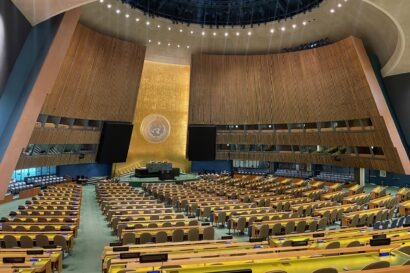Reforming global corporate taxation
Proposals from the Biden administration have injected new life into the international process to reform the taxation of multinational enterprises (MNEs), but achieving a fair and effective outcome remains problematic. Greater attention must be paid to the perspective of lower-income countries and proposals they have made for more comprehensive reforms that could also simplify the system, most recently from African countries through the African Tax Administration Forum (ATAF).
The negotiations are based at the Organisation for Economic Cooperation and Development (OECD), and conducted through the Inclusive Framework on BEPS (base erosion and profit shifting), which the G20 leaders opened to all states, and now has 139 members. They have two elements: reforming taxation of MNEs to deal with the impact of digitalisation of the economy (Pillar 1), and a proposed global minimum tax on MNEs (Pillar 2).
Detailed technical blueprints were published by the OECD secretariat in October 2020, followed by a public consultation, and these are now being revised in a blend of political and technical negotiations. The hope is to reach an outline agreement in July at the full meeting of the Inclusive Framework, and a final one by the October meeting of the G20 Finance Ministers.
Agreement needs a ‘consensus’ among all participants, backed by a political commitment. However, implementation would require participating countries to revise both their domestic laws and international rules. The October blueprints entailed a multilateral treaty of a kind never before achieved.
Treaty ratification in most countries requires parliamentary approval, taking time and political determination. This would be particularly problematic for the US, where a two-thirds vote is needed in the Senate, a steep hurdle especially in the current political context. So, the challenge is to devise a package backed by enough states for a critical mass, and in a form that can be implemented by feasible legal measures.
Pillar One: Tax Challenges Arising from Digitalisation
US proposals
The Biden proposals would greatly streamline the blueprint, by targeting only the largest and most profitable MNEs. Simplification by using quantitative measures based mainly on MNEs’ financial accounts would greatly reduce the complexity and uncertainty of the criteria for defining the ‘automated digital services’ and ‘consumer-facing business’ that the blueprint aimed to cover.
The US also proposes high thresholds for size and profitability, so that perhaps as few as one hundred MNEs would be covered. The suggestion is that, since these would be the most highly profitable MNEs, reallocating a 20% share of their excess profits to the countries from which MNEs derive revenues, even without a physical presence, could still produce close to the $5-12 billion in additional tax revenue worldwide from Pillar 1.
This would be far easier to implement than the Pillar One blueprint, through agreements administered by panels of representatives from the relevant tax authorities, led by each MNE’s home country authority. It could also be done without treaty changes, under a legal framework between the administrations concerned, provided that such agreements could be sufficiently binding.
The previous US administration’s proposal for implementation through ‘safe harbours’ was rejected by other states because it depended on each MNE’s consent. This has been dropped, but the problem remains. An alternative would be an intergovernmental agreement, which the US could treat as an executive agreement, dispensing with the need for Senate approval. However, a means would need to be found to make the scheme binding on the MNEs concerned. They would expect guarantees that the scheme would do no more than reallocate tax, and not result in any additional burden.
Current discussions are focused on defining which MNEs would come within the scheme, and how much profit would be reallocated. It would not resolve all the problems of taxing e-commerce, so there would also be a mechanism for monitoring the acceptability, especially to the US, of taxes on digital transactions.
Developing country proposals
However, lower-income countries are concerned that this scheme would do little for them, and an alternative has been put forward by ATAF. This would calculate the profit to be reallocated as a portion of the MNE’s total profits rather than only its excess profits. The method proposed is to apply a required return on local sales revenues based on each MNE’s global operating margin, with a higher rate of return for those with higher global profit margins. ATAF argues that this would be much easier to administer, so it could apply to MNEs above €250 million turnover instead of €750 million. This is a variation on a proposal made in 2019 by the G24 group of developing countries, and they are also pressing for simplified methods and lower thresholds.
These proposals challenge the assumptions of OECD countries that the ‘residual’ profits of MNEs are mainly attributable to their home countries, and activities in other countries around the world only result in ‘routine’ profits. This view entirely overlooks that MNEs derive their super-profits from the economies of size and scope and synergies due to their dominance of global markets. The blueprints have partly accepted this by proposing a formulaic allocation to ‘market’ jurisdictions, but only for a few of the largest MNEs, and with no rationale for the amounts apportioned.
The ATAF proposal, like that of the G24, provides a more comprehensive approach that offers a way forward rather than a stop-gap and partial solution. It would not resolve the implementation problem, particularly for the US, but African countries generally have only a few tax treaties.
With stronger political commitment such wider reforms could be introduced by reconsidering the interpretation of treaties, without revising the actual texts. Existing treaty provisions allow states to adjust the accounts of the local affiliates of MNEs, to ensure that they are taxed in line with similar local independent businesses. This has been interpreted very narrowly, particularly in the OECD’s Guidelines on Transfer Pricing, to require affiliates to be taxed as if they really are independent.
A different interpretation could allow taxation by apportioning the MNE’s global profits, applying factors reflecting its real presence in each country (employees, physical assets and sales), building on the existing profit split method. Furthermore, as the G24 proposal pointed out, a large number of existing tax treaties already allow fractional apportionment for attributing profits to a ‘permanent establishment’. Taxation of MNEs as unitary enterprises in this way is the only effective means to fulfil the commitment from the G20 leaders in 2013 to tax MNEs where their activities occur.
Pillar 2: The Global Minimum Corporate Tax (GLOBE)
A global minimum corporate tax has much greater potential, especially at the 21% rate proposed by the US. The OECD’s proposed GLOBE (global anti-base-erosion) tax has two main components: one for the MNE’s home country to target low-taxed foreign profits (the income inclusion rule, IIR), and the other for host countries to block shifting of profits to low-tax jurisdictions (the undertaxed payments rule, UTPR). The Pillar 2 blueprint is based on measures already introduced by the US in 2017, which the Biden administration intends to greatly strengthen: the GILTI (global intangible low-taxed income) tax, which applies to US-based MNEs, and the BEAT (base erosion anti-abuse tax) applying mainly to non-US MNEs.
The Biden administration intends to give real teeth to these and bring them more in line with the GLOBE, as discussed recently here. First, the GILTI would apply on a per country basis (like the GLOBE), and the rate would double from 10.5% to 21%. Secondly, the BEAT would be replaced by the SHIELD (Stopping Harmful Inversions and Ending Low-tax Developments) tax, operating in tandem with the GILTI, and using the same methodology to specify the low effective tax rate.
The US commitment to a minimum rate of 21% sets a much higher bar than has been considered until now for Pillar 2. The US has now stated that a 15% rate should be the floor, and discussions should aim to push it higher. This could be done by agreeing to an immediate rate of 15%, increasing in stages to 20% and 25%, to create an upward ratchet. As important as the rate is the methodology used for calculating the effective tax rate. The blueprint left some key issues open, notably the treatment of capital allowances, and these have been the focus of intense lobbying by business.
A robustly defined minimum tax would create a real prospect for strong and effective international measures to finally halt the beggar-thy-neighbour tax competition that damages all states. Developing countries generally have very high nominal corporate tax rates (30% or more), but these are undermined by incentives aimed mainly at foreign investors, creating competitive disadvantages for local business.
Home vs. host country allocation of taxing rights
A significant flaw in the Pillar Two blueprint is that it proposes to give priority to MNEs’ home countries to tax undertaxed profits. Host country measures would only be a fall-back, even though they are the source of these undertaxed profits. The blueprint recognises that this would be grossly unfair, particularly to smaller and poorer countries that are mainly or only hosts to MNEs.
So, a third measure is proposed, a subject-to-tax rule (STTR), allowing application of withholding taxes at source, which would have priority over the IIR. Lower-income countries insist that this should be an integral part of Pillar Two. However, the STTR would require changes to tax treaties, effectively handing a veto to countries that have designed their treaties and other measures to enable sheltering of low-taxed income. The likelihood is that the GLOBE would go forward, to be implemented by willing states, leaving the STTR to come in once treaty changes are implemented. But there seems little reason for countries that are mainly hosts to MNEs to accept a scheme that would give priority to home country taxes.
This makes it essential to ensure that the GLOBE itself provides a balanced allocation of taxing rights for all states, to facilitate its wide acceptance and adoption. The GLOBE’s proposed priority for home countries could not be enforced without a binding agreement, which there would be no incentive for host countries to accept. Equally, it is not clear that even OECD countries would renounce the measures they have introduced to protect their own source tax base, such as the UK’s diverted profits tax, or the US’s BEAT/SHIELD. The GLOBE should be modified to provide a balanced allocation of taxing rights that all countries could apply to MNEs, wherever their home country may be.
A better GLOBE
To provide a fairer and more effective solution, a revised version of the GLOBE has been put forward by a group of researchers (of which I am one): a minimum effective tax rate (METR) for multinationals. This would combine the two elements of the GLOBE into a single formulary apportionment rule that could be applied by all countries to both inward and outward investment alike.
Dispensing with the need for priority rules would ensure fairness between countries, and non-discrimination between home-based and foreign-based MNEs. Dispensing with the need to manage the interaction of different rules would also simplify administration of the measure. The METR would allocate profits that have been taxed below the agreed minimum effective tax rate among countries, using factors reflecting the MNE’s real presence in each country (employees, physical assets and sales to customers). Each such country could apply to these apportioned undertaxed profits its own tax rate, whether it is above or below the agreed minimum rate.
This would of course not be a complete solution. Although the METR could go ahead without the need for a treaty, some important changes should be made to existing international rules to facilitate its application, particularly by host countries. This could be done by revising the interpretation of treaties, as suggested above, to allow taxation of affiliates on an apportioned share of the MNE’s global profits. A mechanism for monitoring and coordinating its implementation would also be needed, to prevent possible conflicts.
The METR’s reallocation of undertaxed profits should be widely welcomed, as our estimates suggest that almost all countries would benefit (see the full data here). Compared to the GLOBE, the METR would produce greater revenues overall and significantly more for lower-income countries (see the table below).
Estimated tax revenue gains for selected countries from the GLOBE and the METR USD million, at a 21% minimum rate
| Country | GLOBE | METR |
| Algeria | 300 | 494 |
| Angola | 159 | 326 |
| Botswana | 43 | 63 |
| Burkina Faso | 9 | 17 |
| Cote d’Ivoire | 28 | 47 |
| Egypt | 523 | 802 |
| Eswatini | 7 | 13 |
| Ethiopia | 176 | 353 |
| France | 25,824 | 28,553 |
| Germany | 39,419 | 47,826 |
| Ghana | 45 | 75 |
| Guinea | 5 | 12 |
| India | 8,329 | 18,034 |
| Ireland | 2,183 | 1,601 |
| Lesotho | 57 | 96 |
| Madagascar | 7 | 9 |
| Malawi | 9 | 18 |
| Mali | 6 | 14 |
| Mauritius | 57 | 57 |
| Morocco | 288 | 577 |
| Nigeria | 810 | 1,617 |
| Senegal | 36 | 66 |
| South Africa | 2,954 | 4,970 |
| Tanzania | 26 | 52 |
| Turkey | 2,044 | 1,555 |
| Uganda | 20 | 40 |
| United Kingdom | 20,868 | 21,280 |
| United States | 165,952 | 148,896 |
| Zambia | 43 | 101 |
| Zimbabwe | 24 | 41 |
NOTE: These are only estimates; for a full discussion of the data limitations and methodology used, see the paper here; full data available here.
Advantages of the METR
Since the METR does not give priority to MNEs’ home countries, the lower-income countries that are mainly hosts would gain proportionately far more. At the same time, because it allows each country to apply its standard tax rate to its apportioned undertaxed profits, rather than the minimum rate as in the GLOBE, it would result in higher overall revenues. Hence, even home countries would benefit, although some would gain a bit less from the METR than from the GLOBE.
This would level the playing field between MNEs and domestic companies, and create an incentive for countries with low rates to increase them. Hence, it is important to set a suitable minimum rate. This should be no lower than the US proposal of 21%, and preferably 25%, as proposed by the Independent Commission for the Reform of International Corporate Taxation, which is the current global weighted average rate. The METR should also apply to all MNEs, subject only to a low threshold of perhaps €50 million to exclude small and medium enterprises.
Achieving effective and sustainable reform
The METR’s formulary global minimum tax should point the way forward to a more comprehensive reform of international tax rules based on unitary taxation of MNEs and formulary apportionment. Proposals to introduce such an approach are already planned by the European Commission (a recent renewal of previous versions), and by India.
This would provide stability and certainty, and greatly reduce administrative costs for MNEs and tax administrations alike. Countries could still compete to attract investment, but it would be to attract real activities and not paper profits. Instead of offering tax incentives aimed at foreign firms, each country would decide its own corporate tax rate applicable equally to MNEs and local firms, and which could fund the well-educated workforce and good infrastructure needed for sustainable economic development.
While the challenges are great, the current conjuncture offers an unprecedented opportunity to devise international tax reforms that would benefit all countries, but especially the poorest that are most reliant on corporate tax revenues. A combination of political determination and creative technical analysis is needed to ensure a successful conclusion. It is only by listening to new voices, such as the proposals from ATAF and the G24, that these negotiations can overcome the obstacles created by defenders of the status quo and achieve the fair and effective reforms the world now needs.



